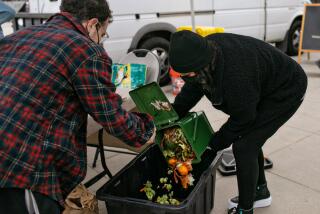Details on Composting, Earthworms Sought
- Share via
QUESTION: We want more information on composting and earthworms: What about using fireplace ashes, dog and cat feces, oleander leaves, etc.?
ANSWER: I’ve had numerous inquiries on these subjects, and have decided to center my response around a good recommendation from Bill McBride of Whittier.
Bill keeps plastic containers under his kitchen sink, and the McBrides place all their unusable produce scraps (spoiled fruit, fruit peelings, potato peelings, waste from lettuce and cabbage, etc.) into these containers.
Then every day he carries the container(s) out to his garden and digs a small hole six to eight inches deep, dropping in the scraps and chopping them with his shovel as he adds back some soil. Finally he covers it all up with the remaining soil.
Depending on the time of year and the temperature, the scraps are usually composted within a week. He digs a new hole each day. The marvel to him is that without any other effort his garden soil is now full of earthworms. Lots of organic matter in the soil is the key to building up earthworm populations.
Bill’s procedure is a good one, because it’s easy and effective. Fireplace ashes may also be successfully used in the compost pile or buried in the garden.
However, dog and cat feces, as a rule, are not considered appropriate for use in compost because of possible contamination with disease-causing organisms, but they may be buried under shrubbery and trees. Manures from vegetarian critters such as rabbits and horses, etc., work fine in compost.
I cannot find any reference to the safety of using oleander debris in compost for vegetable gardens, but I would not take a chance if I were you.
Oleander sap contains two extremely toxic glycosides (nerioside and oleandroside). According to several authorities, eating any part of an oleander plant, even a single leaf--or breathing the fumes from burning oleander leaves or stems--can be fatal.
Fortunately, most people seem to know about this plant, because there are very few known poisoning from oleanders even though these plants are grown almost everywhere in the Southland. So, why take a chance, especially if you plan to use your compost around edible crops in the vegetable garden?
Growing Apricots When Space Is Limited
Q: I would like to grow apricots in my yard but don’t have space for a full-size tree. Any suggestions?
A: Apricot trees on dwarfing rootstocks do well in our area, reaching a mature height of about 10 feet with proper pruning. (Apricots tend to form long, relatively straight stems. The trick is to cut back these long stems as they form in the summertime, so they will branch out into shorter, spur-like stems on a main framework.) Choose Dwarf Royal or Dwarf Nugget inland and Dwarf Blenheim or Dwarf Royal near the coast.






